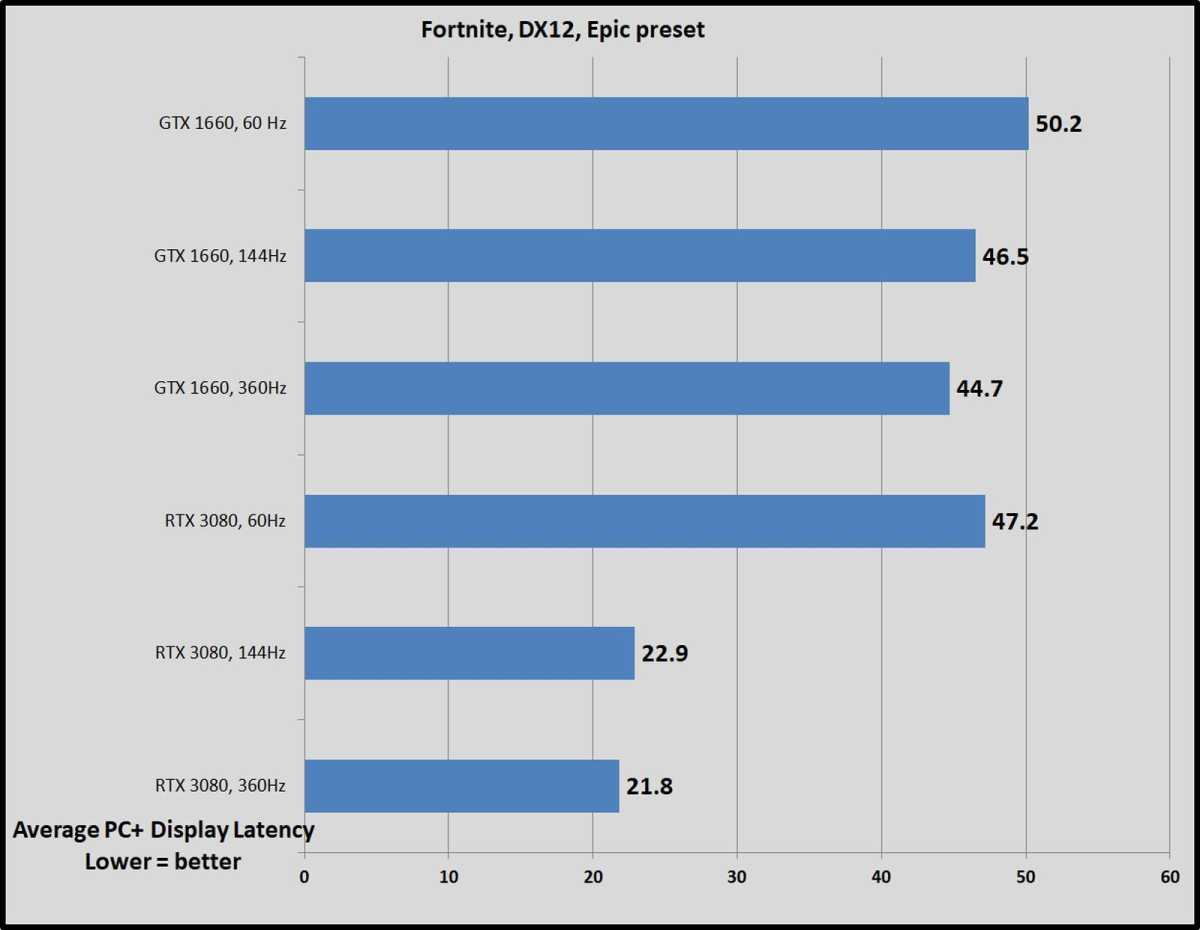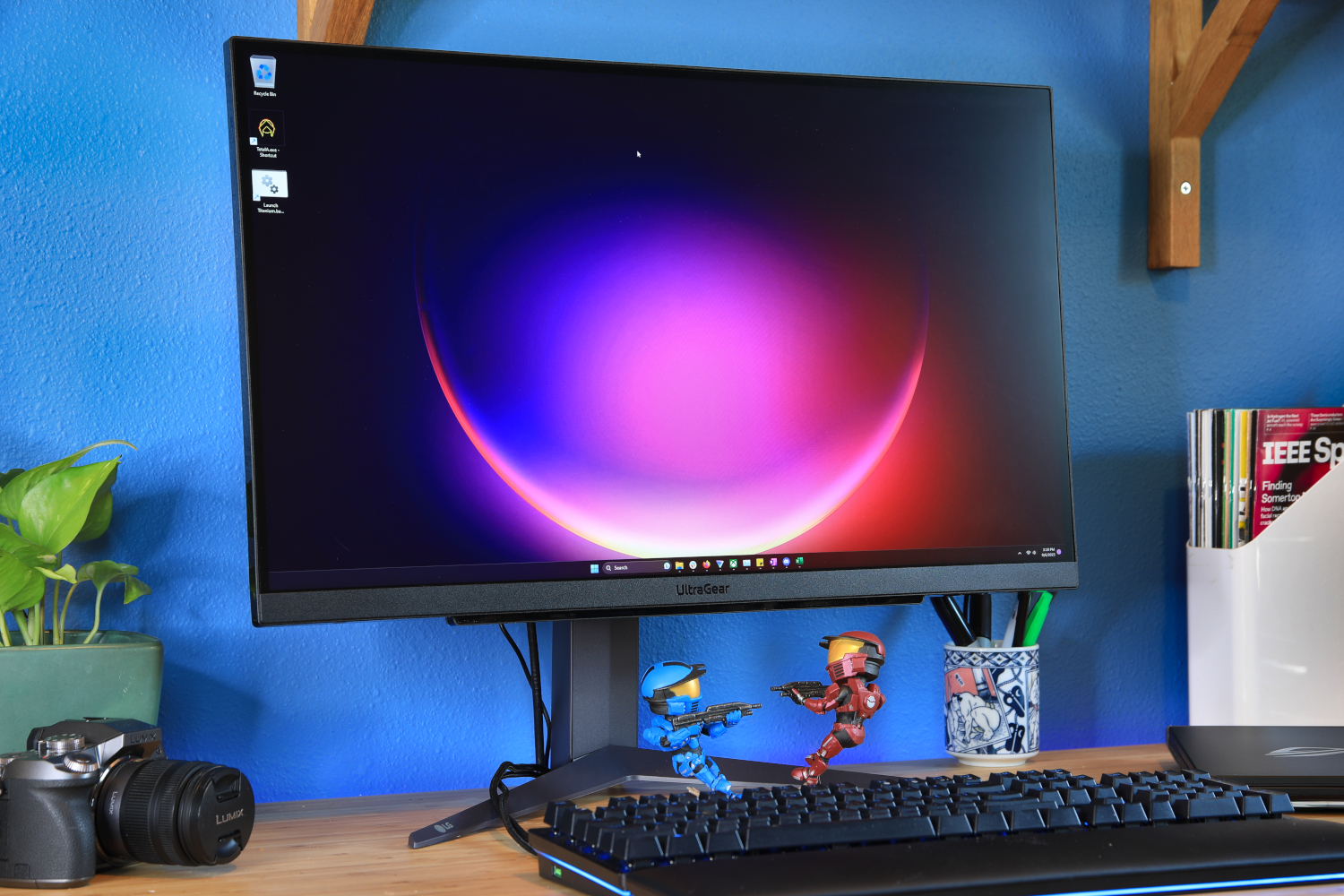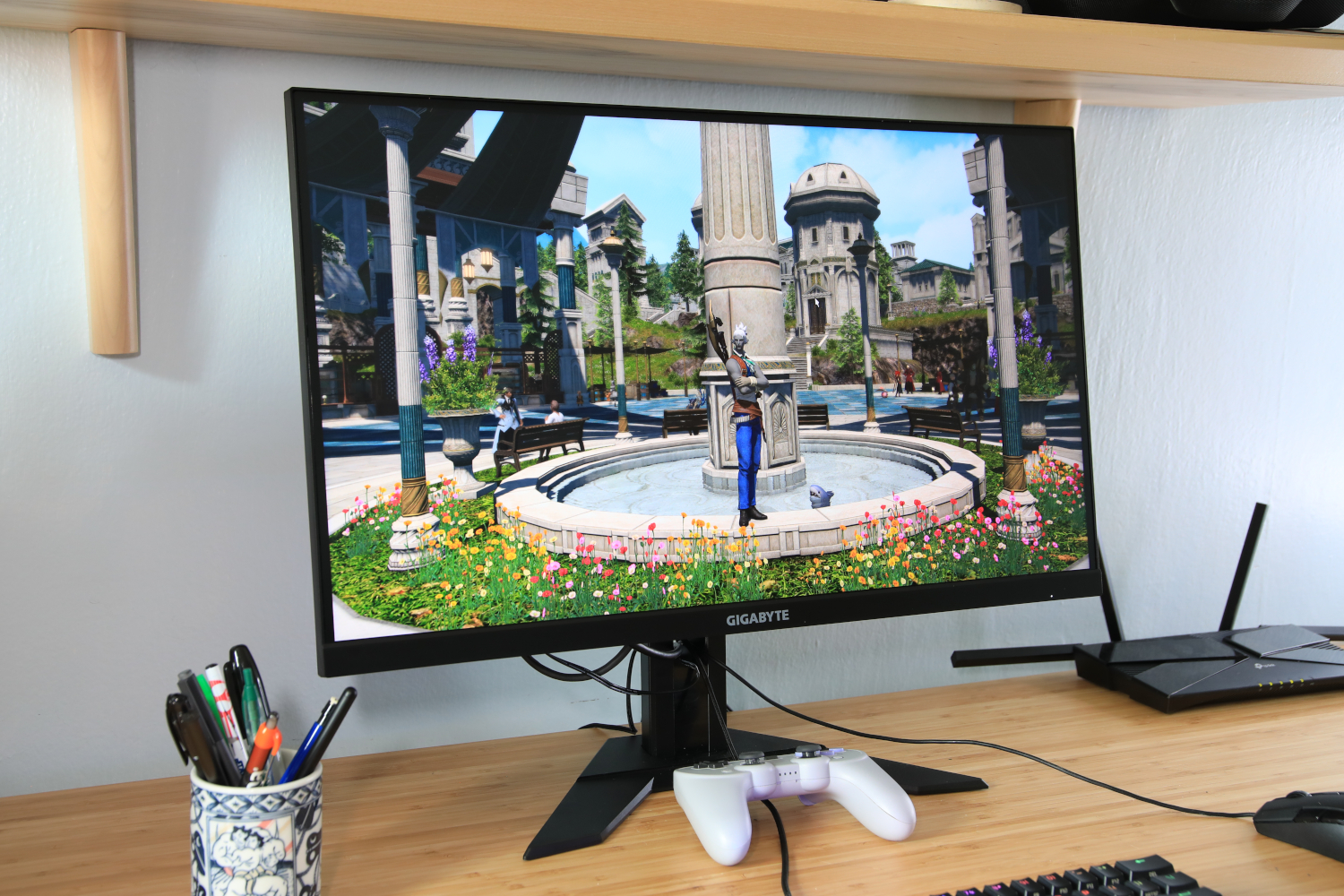2023 saw the release of Alienware’s AW2524H, the world’s first 500Hz monitor. Unbelievably, it will likely be superseded by the even faster 540Hz Asus ROG Swift Pro PG248QP, which should hit retailers by the end of the year.
These displays are good news for the most extreme competitive players, but they’re also good news for the rest of us. Each new monitor with a cutting-edge refresh rate brings a price cut to last year’s best. A quality 240Hz monitor with 1440p resolution, like the LG UltraGear 27GR83Q-B, can now be purchased for $400 or less. Stick with 1080p and you can have 240Hz for as little as $250. Even 360Hz monitors now limbo under $400.
The world of 240Hz (and beyond) is becoming affordable, even sensible—and the benefits aren’t reserved to PC gamers.
Further reading: The best gaming monitors for any budget
High refresh rates look amazing in PC games
The benefits of an improved refresh rate are easy to spot in PC games. A higher refresh rate improves motion resolution, which means you’ll see details you couldn’t at a lower lower refresh rate.
I often use League of Legends and DOTA 2 as an example in reviews, and for good reason: These games display many small, fine details in character models, effects, and the interface.

Fast-paced games like DOTA 2 look crisp on a high-refresh monitor.
Valve
Scrolling across either game on a 60Hz monitor reveals a blurry mess with only vague details of characters and terrain visible. Increasing the refresh rate to 144Hz makes terrain and character detail easy to pick out. Boosting to 240Hz improves the clarity of spell effects and makes character names and hitpoint bars more legible, but 360Hz is required to make them comfortable to view in motion. 500Hz is better still, providing a crystal-clear feel that seems only slightly worse than a static image.
Competitive first-person shooters, on the other hand, benefit most when quickly turning (as you might when ambushed from behind). The improved motion clarity of a high refresh rate makes the level, and your foes, easier to see while the camera is in motion, improving your ability to understand your situation.
But it’s a mistake to think the benefits only apply to competitive games. The improved clarity is just as visible in Stellaris or Civilization IV as it is in League of Legends. You’re not going to win or lose a game because of it, of course, but fine fonts and icons will prove easier to see on the move. You’ll enjoy similar benefits in open-world role-playing games, where you’ll better appreciate stunning vistas as you sprint between quests and retain the legibility of quest icons and markers while turning the camera.
But refresh rate isn’t just for gamers
I often hear it said that high refresh rates only apply to gamers. Indeed, I’ve probably said that myself more than once in the past. But I’m starting to rethink this, because there’s a killer app that runs beautifully at 144Hz, 240Hz, 360Hz, and even 500Hz: Microsoft Windows.
Here’s the thing: everything I’ve said about motion clarity and resolution applies just as strongly to Windows as it does to games. A 240Hz display makes text and health bars above League of Legends characters easier to read—and it does the same when scrolling through a PDF document.
The results are meaningful. As you might’ve noticed, modern life involves a lot of scrolling: through social media feeds, through YouTube recommendations, through Amazon results, and so on. A higher refresh rate directly improves the readability of text and thumbnails as you scroll through these apps and websites.
It also makes the operating system feel snappy. Lower input latency is also a factor, but I think smoother rendering of graphics and animations is what’s most responsible. Many modern smartphones, from the iPhone to Samsung’s Galaxy line, have moved to a 120Hz display for precisely this reason.
I’ve become so accustomed to these benefits, in fact, that I’m cursed: I can now readily tell when the Windows Desktop is running at 60Hz. The entire operating system feels slower, clunkier, and antiquated.
Still not convinced? Here’s why refresh rate matters
Many technologies in our lives operate at fairly low frequencies. Most light bulbs flicker, with the frequency varying from 50Hz to 120Hz or more (depending on the bulb). And many modern displays, like the OLED display on the iPhone 15, flicker at a particular frequency to regulate brightness, a technique called pulse width modulation (PWM).
People won’t typically notice flicker from these sources (though some can experience headaches, eyestrain, or nausea), which seems to create a contradiction. If the human eye can’t perceive flicker from these sources, how can a high refresh rate monitor improve motion?
Interestingly, the phenomena that makes high-frequency variations in brightness unnoticeable also makes improved refresh rates noticeable on modern displays.
It’s called “persistence of vision.” Our brains don’t immediately react when light is removed. Instead, the impression remains for a short time. Many older display technologies rely on this. A CRT’s scan line moves at lightning speed as it races across the display from top to bottom, lighting phosphors in its wake. Yet the moving scan line is invisible. The CRT appears uniformly lit.
However, modern displays introduce wrinkles which don’t mesh well with our persistence of vision.
All modern PC monitors are “sample and hold” displays, meaning the entirety of a frame is held and remains visible until the next frame appears. The presentation of static frames creates a disconnect between the rate at which the eye moves to track motion and the lack of movement of each static frame. Persistence of vision smears this into a single, blurry result. Blur Busters has an excellent test that shows this in action, as well as several excellent articles that explore the topic in-depth.
Blur can be reduced by lowering the amount of time each frame is displayed. If the frame is visible for a shorter period of time, a viewer’s eyes spend less time tracking across the static frame, reducing the effect of persistence of vision and improving motion resolution. High refresh rate displays achieve this by displaying more frames each second. A frame lingers on a 60Hz monitor for 16.667 milliseconds. A 240Hz monitor cuts that to a mere 4.166 milliseconds. And a 500Hz monitor displays each frame for just 2 milliseconds.
This explanation should make the benefits of a high refresh monitor easier to understand. It implies not only that a higher refresh rate is better than a lower refresh rate, but also that the maximum useful refresh rate is very high—certainly no less than 1,000Hz, a refresh rate no consumer monitor can currently achieve.
Don’t forget about latency
And there’s a bonus benefit: reduced input latency (the time between a key is pressed and the on-screen result).
As I previously explained, increasing the refresh rate reduces the time each frame is displayed. That in turn reduces input latency, as the time spent waiting for a new frame to appear decreases as refresh rate increases.
How much this matters is up for debate. A 2014 study from MIT found humans can process visual stimulus in as little as 13 milliseconds. The setting was much different from PC gaming, however, so it’s unclear how directly the result might apply. PCWorld’s own Executive Editor, Brad Chacos, examined total system latency at a variety of refresh rates and found that moving from a 60Hz to 360Hz display could reduce total system input lag by as much as 28 milliseconds (in Fortnite at Epic detail) or as little as 8 milliseconds (in Valorant at Low detail).

High refresh monitors also reduce input latency.
Brad Chacos/IDG
I’d guess most people will find these differences tough to perceive. But if MIT’s research is applicable to gamers, it implies the latency improvements high-refresh monitors provide are perceptible to the most sensitive players.
2023 is an ideal year to buy a high-refresh display
We’ve taken a long tour through the many benefits of high refresh displays. They improve motion resolution and reduce input latency, two traits that are critical to the perception of a smooth, crisp, and responsive PC. But these are only half the reason why now is the ideal time to upgrade to a higher refresh rate. The other half is found in the major price cuts 240Hz and 360Hz displays received this year.
LG UltraGear 27GR83Q-B is the perfect example. It’s a 27-inch, 1440p, 240Hz gaming monitor with excellent image quality that retails for as little as $349.99 on Amazon. That’s less than the typical retail price of the outgoing 27GL83A-B (a 27-inch, 1440p, 144Hz monitor) at the end of 2021. The 27GL83A-B is still for sale, but it’s now priced at just $250.
Or consider the Alienware AW2523HF. It’s the successor to Alienware’s AW2521H, the company’s first 360Hz monitor, which sold for $899.99 at launch. Today, you can pick up the AW2523HF for as little as $299.99 (though it’s more commonly available for $420). That’s a three-fold reduction in price over three years.
It’s natural to expect new technology to become affordable over time, but the current pace of price cuts is incredible. It’s also unlikely to last, as future improvements in refresh rate may prove difficult. I recently spoke with Dell’s VP of Displays, Yoon Lee, for IEEE Spectrum, and the challenges she laid out are significant. Pushing past 500Hz will require new display technologies, new connection technologies, and more powerful GPUs.

Brad Chacos/IDG
For now, however, GPUs lean in favor of high refresh displays. The Blockchain fury is over and video card pricing, though still steep compared to a decade ago, is tolerable.
Mid-range cards priced around $500 can power high refresh rates in many games. PCWorld’s review of the Nvidia RTX 4070 found that six out of 10 games tested at 1440p resolution averaged more than 120 frames per second (with ray-tracing off). Our review of the AMD Radeon 7800XT found that five out of eight tested games beat an average of 120 frames per second. Many of the most popular PC games, like Counter-Strike, DOTA 2, and Apex Legends, can breeze along at hundreds of frames per second on relatively inexpensive video cards like the Nvidia RTX 4060 and AMD Radeon 7600 XT.
Further reading: The best graphics cards for PC gaming
Conclusion: Strike now for maximum hertz per dollar
This is a fantastic moment for PC gamers. High refresh rate monitors have drastically improved motion clarity, yet monitor prices have dropped like a rock, and video cards capable of powering games at appropriate framerates are finally (somewhat) affordable. I expect the holiday 2023 season will see even the best PC gaming monitors slashed to bargain-bin prices.
It’s possible this trend will continue into 2024, but there’s reason for worry. The popularity of AI could put new pressure on the GPU market, increasing prices and availability. I also suspect monitor prices could return to an upward trajectory next year. The COVID panic sent monitor manufacturers for a wild ride as demand spiked and then sharply fell, causing a glut of inventory. A return to “normal” likely means higher prices in the future.
In short: if you’ve been on the fence about buying a new 240Hz or 360Hz monitor, this is your moment.






